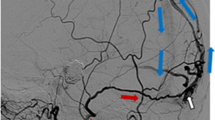Abstract
Purpose
Dural arteriovenous fistulas (AVFs) draining to medullary bridging vein (MBV) are located at foramen magnum (FM) and craniocervical junction (CCJ). Such fistulas are rare but pose a challenge to endovascular management. This study was undertaken to assess clinical manifestations, angiographic features, and outcomes of endovascular treatment in patients with MBV dural AVFs.
Methods
A number of our patients (N = 22) were diagnosed with MBV dural AVF and treated by endovascular means. There were 9 FM lesions and 13 CCJ lesions. We reviewed clinical records and imaging studies to define clinical characteristics, vascular anatomic details, and treatment outcomes, comparing FM- and CCJ-level subsets.
Results
Subjects ranged from 37 to 74 years of age (mean, 57.7 years) with male predominance (2.7:1). They presented with intracranial hemorrhage (11/22, 50%), myelopathy (8/22, 36%), or nonspecific symptoms (3/22, 14%). In 17 patients (77.3%), the shunts showed complete or near-complete occlusion following endovascular treatment (FM, 100%; CCJ, 61.5%). However, seven patients experienced ischemic events (FM, 11.1%; CCJ, 46.2%) and one patient sustained a hemorrhagic complication. No hemorrhages recurred during follow-up monitoring, and myelopathic symptoms abated.
Conclusion
MBV dural AVFs are highly aggressive lesions for which proper diagnosis and treatment are of utmost importance. Although transarterial embolization proved highly successful in FM lesions, shunt occlusion was less frequent in the CCJ subset, with greater risk of ischemic complications.


Similar content being viewed by others
Data availability
Not available (personal medical records).
Code availability
Not applicable.
References
Cognard C, Gobin YP, Pierot L et al (1995) Cerebral dural arteriovenous fistulas: clinical and angiographic correlation with a revised classification of venous drainage. Radiology 194:671–680. https://doi.org/10.1148/radiology.194.3.7862961
Borden JA, Wu JK, Shucart WA (1995) A proposed classification for spinal and cranial dural arteriovenous fistulous malformations and implications for treatment. J Neurosurg 82:166–179. https://doi.org/10.3171/jns.1995.82.2.0166
Geibprasert S, Pereira V, Krings T et al (2008) Dural arteriovenous shunts: a new classification of craniospinal epidural venous anatomical bases and clinical correlations. Stroke 39:2783–2794. https://doi.org/10.1161/STROKEAHA.108.516757
Li C, Yu J, Li K et al (2018) Dural arteriovenous fistula of the lateral foramen magnum region: A review. Interv Neuroradiol 24:425–434. https://doi.org/10.1177/1591019918770768
Caton MT, Narsinh KH, Baker A et al (2021) Dural arteriovenous fistulas of the foramen magnum region: clinical features and angioarchitectural phenotypes. AJNR Am J Neuroradiol. https://doi.org/10.3174/ajnr.A7152
Mitsuhashi Y, Aurboonyawat T, Pereira VM et al (2009) Dural arteriovenous fistulas draining into the petrosal vein or bridging vein of the medulla: possible homologs of spinal dural arteriovenous fistulas. Clinical article J Neurosurg 111:889–899. https://doi.org/10.3171/2009.1.JNS08840
Hiramatsu M, Sugiu K, Ishiguro T et al (2018) Angioarchitecture of arteriovenous fistulas at the craniocervical junction: a multicenter cohort study of 54 patients. J Neurosurg 128:1839–1849. https://doi.org/10.3171/2017.3.JNS163048
Motebejane MS, Choi IS (2018) Foramen magnum dural arteriovenous fistulas: clinical presentations and treatment outcomes, a case-series of 12 patients. Oper Neurosurg 15:262–269. https://doi.org/10.1093/ons/opx229
Reinges MH, Thron A, Mull M et al (2001) Dural arteriovenous fistulae at the foramen magnum. J Neurol 248:197–203. https://doi.org/10.1007/s004150170226
Zhao J, Xu F, Ren J et al (2016) Dural arteriovenous fistulas at the craniocervical junction: a systematic review. J Neurointerv Surg 8:648–653. https://doi.org/10.1136/neurintsurg-2015-011775
Choi HS, Kim DI, Kim BM et al (2012) Endovascular treatment of dural arteriovenous fistula involving marginal sinus with emphasis on the routes of transvenous embolization. Neuroradiology 54:163–169. https://doi.org/10.1007/s00234-011-0852-4
Zhong W, Zhang J, Shen J et al (2019) Dural arteriovenous fistulas at the craniocervical junction: a series case report. World Neurosurg 122:e700-712. https://doi.org/10.1016/j.wneu.2018.10.124
Soderman M, Edner G, Ericson K et al (2006) Gamma knife surgery for dural arteriovenous shunts: 25 years of experience. J Neurosurg 104:867–875. https://doi.org/10.3171/jns.2006.104.6.867
Geibprasert S, Pongpech S, Armstrong D et al (2009) Dangerous extracranial-intracranial anastomoses and supply to the cranial nerves: vessels the neurointerventionalist needs to know. AJNR Am J Neuroradiol 30:1459–1468. https://doi.org/10.3174/ajnr.A1500
Newton TH (1968) The anterior and posterior meningeal branches of the vertebral artery. Radiology 91:271–279
Lasjaunias P, Vallee B, Person H et al (1985) The lateral spinal artery of the upper cervical spinal cord. Anatomy, normal variations, and angiographic aspects. J Neurosurg 63:235–241. https://doi.org/10.3171/jns.1985.63.2.0235
Siclari F, Burger IM, Fasel JH et al (2007) Developmental anatomy of the distal vertebral artery in relationship to variants of the posterior and lateral spinal arterial systems. AJNR Am J Neuroradiol 28:1185–1190. https://doi.org/10.3174/ajnr.A0498
Vaidya S, Tozer KR, Chen J (2008) An overview of embolic agents. Semin Intervent Radiol 25:204–215. https://doi.org/10.1055/s-0028-1085930
Miyamoto N, Naito I, Shimizu T et al (2015) Efficacy and limitations of transarterial acrylic glue embolization for intracranial dural arteriovenous fistulas. Neurol Med Chir (Tokyo) 55:163–172. https://doi.org/10.2176/nmc.oa.2014-0223
Krings T, Geibprasert S (2009) Spinal dural arteriovenous fistulas. AJNR Am J Neuroradiol 30:639–648. https://doi.org/10.3174/ajnr.A1485
Author information
Authors and Affiliations
Corresponding author
Ethics declarations
Conflict of interest
The authors declare that we have no conflict of interest.
Ethical approval
This study was approved by Seoul National University Hospital Institutional Review Board.
Informed consent
Informed consent was waived (retrospective study).
Consent for publication
Consent for publication waived (retrospective study).
Additional information
Publisher's note
Springer Nature remains neutral with regard to jurisdictional claims in published maps and institutional affiliations.
Supplementary Information
Below is the link to the electronic supplementary material.
Rights and permissions
About this article
Cite this article
Yoo, D.H., Cho, Y.D., Boonchai, T. et al. Endovascular treatment of medullary bridging vein-draining dural arteriovenous fistulas: foramen magnum vs. craniocervical junction lesions. Neuroradiology 64, 333–342 (2022). https://doi.org/10.1007/s00234-021-02790-z
Received:
Accepted:
Published:
Issue Date:
DOI: https://doi.org/10.1007/s00234-021-02790-z




